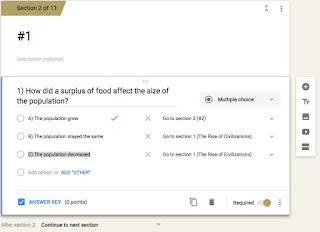 |
| Hunter-gatherers "fighting" over scarce resources |
To this day, I learn by doing. I need the opportunity to create, move, build, and engage in my learning, and I know most of my students need these opportunities also. During the first week of school, I gave my students two learning style quizzes. One online and another paper quiz. I give them two to confirm results and record trends. This year, around 75% of my sixty-two 6th graders' test results showed that 1 of their 2 top learning styles was kinesthetic (hands-on) learning. This information spoke volumes to me. I needed to make sure to create lessons where my students could do, create, move, build, and engage in their learning.
My students and I have been reading, discussing, and researching all things early humans and the origins of ancient civilizations. These kids have shown an interest in learning about civilizations, but during discussions, I could tell many students were having a difficult time with the idea of the jump from hunter-gatherer life to working together to create a civilization. They understood the why behind this jump- it was easier. These early people were working smarter not harder; however, it was hard for them to grasp the time frames. We created a timeline as a class (using their active journals and dates in the textbook) but those were just dates, and I could see that they weren't connecting the concepts.
I decided to use an activity that I found years ago and make some tweaks to create an inquiry lesson. First, I wanted to create a simulation was they were hunter-gatherers. I hide paper slips all over the room with different animals, and food unit amounts on each (ex: Deer- 9 units, fish-4 units). I also had a bin of water in the front of the room which was label "River Merry." Their mission in "Life 1" was to work with their table partner to gatherer a Dixie cup of water and hunt for 30 units of food. This task sounded easy to some students until I showed them the spoon that they'd used to be gathering the water (haha). I explained that their life would last 7 minutes and that if they had one cup of water and 30 food units than they'd survive life as a hunter-gatherer. The next 7 minutes in my classroom was chaotic, but when the 7 minutes was up I polled the class for survivors and only two groups were able to complete the task! We recorded our results and reflected on the task before moving onto our next life. As a class, we decided that the hunter-gatherer life was a difficult one.
In "Life 2", partner groups worked with their table groups (4-6 students) to run a successful civilization. To do this, students needed to collect information about the origins of the first civilizations together and check their answers using a Google Forms "quiz" I put together. The questions were focused on a surplus of food, trade, and specialization of jobs, and I got most of the questions from the lesson checks in the textbook. The students were told that the first group to successfully work together would earn a surplus of food and water for their whole civilization. The next 10-15 minutes were full of my students working together to beat the other civilizations. Chaotic learning at its finest! In the end, each team found their way (a.k.a the correct answers) to the surplus of food and water. And after reflecting on the task, we came to two conclusions: 1) When people started working together, civilizations thrived and innovations were created. 2) Working as a group and moving around the classroom is more fun.
"Today was fun, Mrs. Merry!"- a quote from multiple students on their way out the door #teacherwin
Here are three fun, simple ways to take the learning out of the textbook in a meaningful way:
- Create an interactive lesson check using Google Forms. To do this, review the lesson's hot topics (main ideas) and type out the questions on the form. Make sure you use the 'Blank Quiz' template. You can play with the question types to include multiple choice, checklist, short answer, scale answer, date, and essay question by selecting the plus sign on the top of the flowing bar (on the right hand side). If you'd like to have each question on a separate page, select the equal sign on the bottom of the flowing bar, and use the drop-down menu to select which slide the students will be taken to depending on their answer. You also need to select the correct answer for each question, so students can move on if they get the answer correct.
- Act it out! Engage students by having them simulate the concepts or important people in the lesson. If students are learning about the social classes of civilization or era, put them in small groups and assign them different classes to act out for the rest of their classmates. Students may also enjoy creating an interview where they take what they have learned while reading and demonstrate it through the questions and answers.
- Hold a live debate to discuss new controversial topics and current events. How harsh should punishments be to hold power over people? Should Christopher Columbus and Thanksgiving be celebrated? What are the pros and cons of trading with other civilizations?

Getting my hands dirty,
Jenni Merry



No comments:
Post a Comment